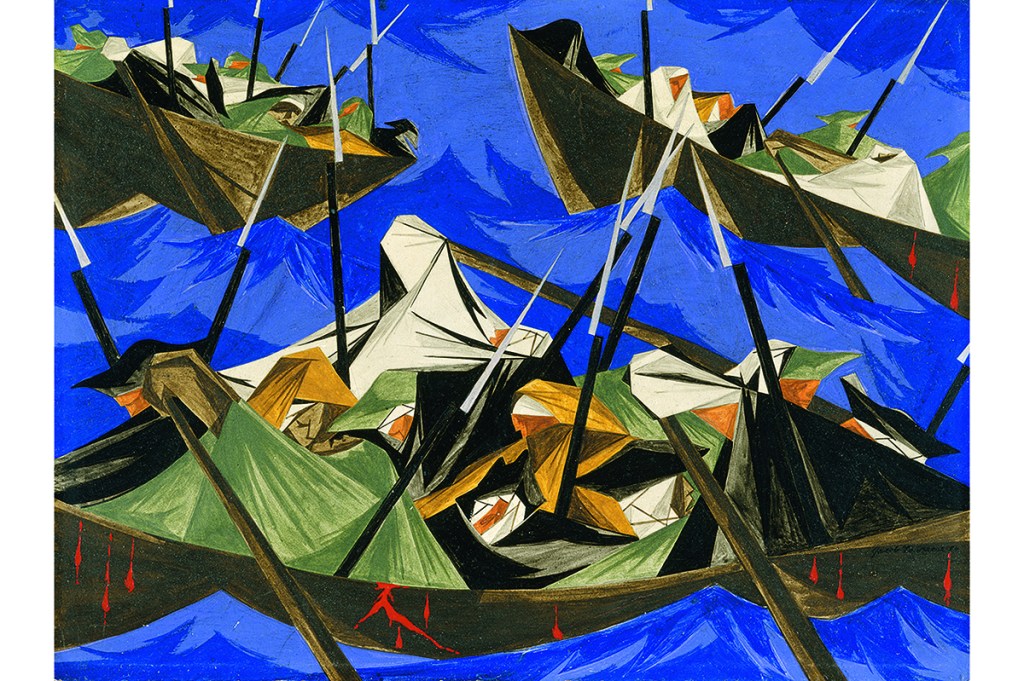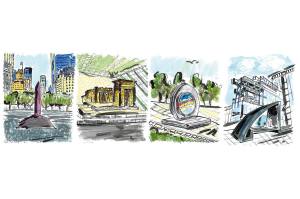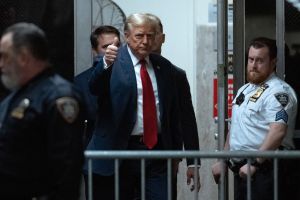Few artworks could be more responsive to the current upheaval than Jacob Lawrence’s 1954-56 series ‘Struggle…From the History of the American People’. Painted during the dawn of the Civil Rights movement, the cycle of 30 panels tells a history of the American Founding through punchy modernist vignettes, engaging with timely and timeless topics such as brutality, race, memory, justice and our shared national heritage. At the Metropolitan Museum of Art, 24 of the original panels have been reunited for the most complete exhibition of the series since its original showing more than six decades ago. The exhibition will travel to Birmingham, Seattle and Washington, DC from New York.
Born in 1917 and trained by several leading lights of the Harlem Renaissance, Lawrence is best known for his ‘Migration Series’ (1940-41), which recounts the ‘Great Migration’ of African Americans from the Jim Crow South to the industrial North. The series was immediately celebrated for its taut economy of means and its poignant evocation of history through abstract design. When it toured the country from 1942-44 it contributed to Lawrence’s growing reputation as, in the words of a later Times critic, ‘the nation’s (and probably the world’s) foremost Negro painter’.
Other early Lawrence work includes visual lives of Harriet Tubman, Frederick Douglass and Toussaint Louverture — all part of his effort to document the history of his race through art. But by the 1950s, a few years out of service in World War Two on the Coast Guard’s first desegregated boat (an experience he called ‘the best democracy I have ever known’), Lawrence sought to widen his painterly vision.
‘This project,’ Lawrence wrote in a grant application to fund the ‘Struggle’ series, ‘has ceased to be the story of the Negro people in America and become the story of the American people.’ Against the backdrop of Brown v. Board of Ed and the onset of the long fight ahead to turn that decision into reality, Lawrence began painting his deeply researched, integrationist history of the Founding Era. ‘Struggle’ thus combines episodes familiar to the traditional telling — Paul Revere’s midnight ride, the Boston Tea Party, Jackson’s victory at the Battle of New Orleans — with often forgotten moments (an 1810 slave uprising, Tecumseh’s Rebellion) which extend the spirit of Patrick Henry to all the participants in this earth-shaking epoch.
Lawrence’s tale is not a ‘let’s hold hands and sing for liberty’ triumph. It’s a violent, gritty and gruesome affair. The sense of ‘struggle’ indicated by the cycle’s title is visible in its characters’ straining gestures and blood-spattered flesh, but also in the paint itself. The egg tempera Lawrence uses is one of the oldest and most durable mediums available to painters, but it’s also fast-drying and translucent, and thus prone to revealing the ‘hand’ of the artist and the work of his brush. Lawrence turns this material quality to his advantage, activating angular Cubist forms with harried, striating marks that feel like muscle.
Lawrence’s abstract language elicits a ‘struggle’ of our own — a struggle of recognition as our eyes strain to attach arms to bodies, distinguish figures from ground and make sense of the events laid before us. Compare Panel 10, which imagines Washington’s nighttime crossing of the Delaware River, to Emanuel Leutze’s iconic treatment of the same subject from 1851, which hangs upstairs in the Met’s American galleries.
Leutze illuminates his well-behaved scene with neoclassical clarity and a sort of assured heroism. Lawrence shrouds each character in the geometry of his cloak and interrupts our sightline of the three — no, four — boats with the razor-sharp edges of the soldiers’ swaying muskets. The caption of the panel quotes a contemporary letter by Washington’s aide-de-camp: ‘We crossed the River at McKonkey’s Ferry 9 miles above Trenton…the night was excessively severe…which the men bore without the least murmur.’ Leutze tells us the story, but Lawrence paints the sensation of living it.
These paintings are small: each measures only 12 x 16 inches. But what Marsden Hartley said of Albert Pinkham Ryder’s work — ‘small in size, incredibly large in its emotion’ — applies to Lawrence’s diminutive panels. Their intrinsic power is multiplied by the cumulative effect of seeing them in series. We take in the story through time, noticing formal and symbolic rhymes and resonances as we move along. And if these threads feel untied as we reach the end of the narrative, that lack of resolution impresses upon us the permanence of struggle as a condition of the American project. That was true in 1776. It was true in 1956. It remains true today.
This article is in The Spectator’s September 2020 US edition.


















